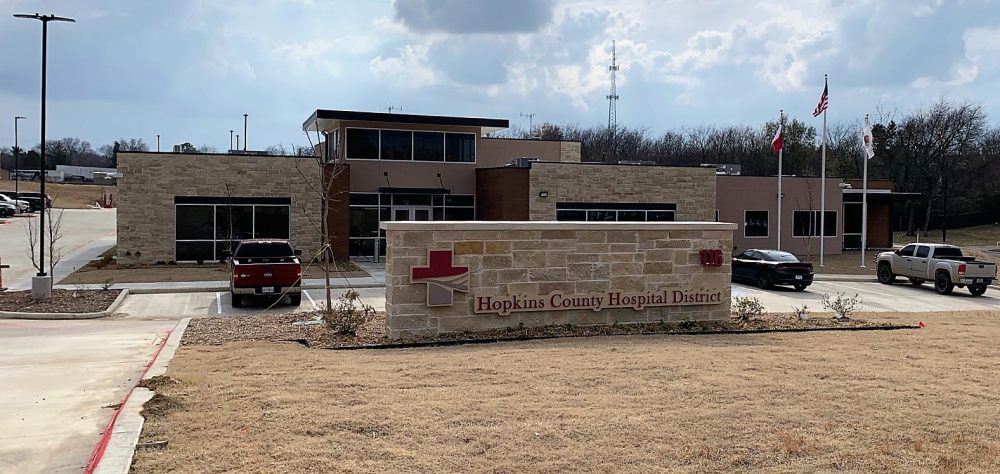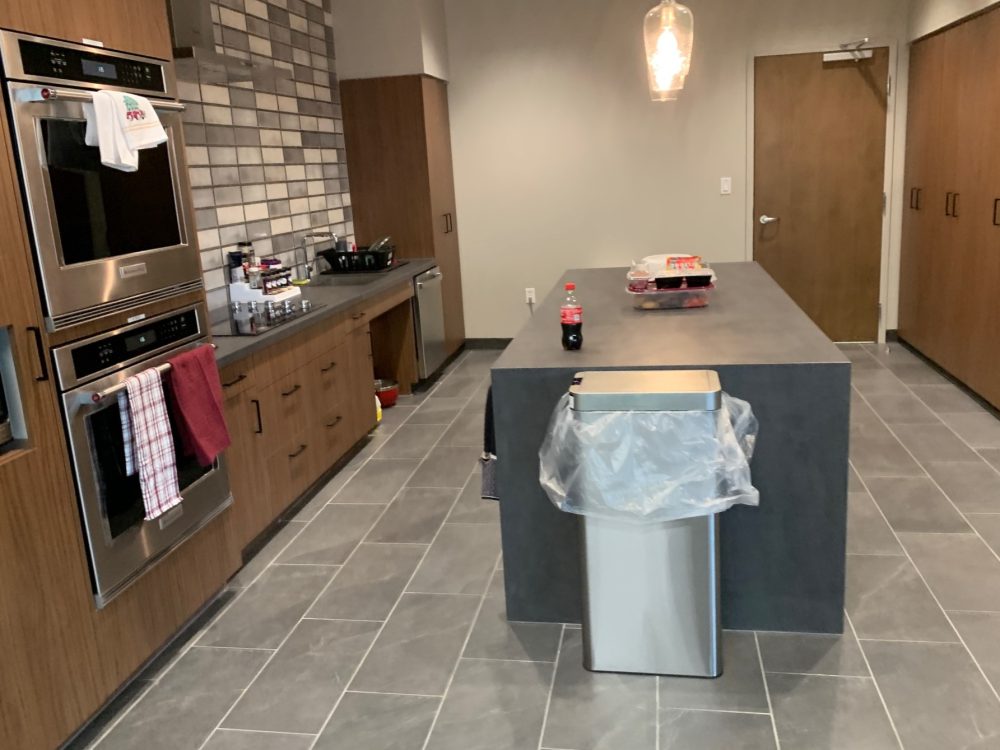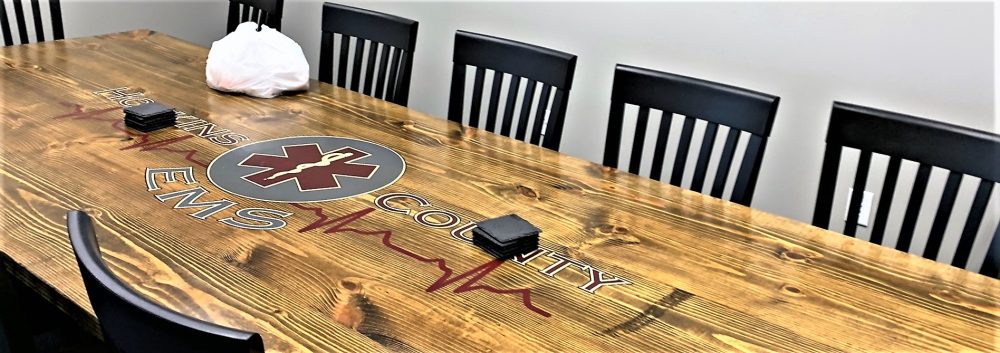Hopkins County EMS and Hospital District made the move in December and are getting settled into their new EMS station and Hospital District Headquarters, located on 116 Airport Road across from their old digs by CHRISTUS Mother Frances Hospital-Sulphur Springs. An open house is planned Jan. 25 for the new building.
The event will begin with a ribbon-cutting at noon, and include a facility dedication with the HCHD Board of Directors, refreshments and guided tours of the facility to give the community an opportunity to see where the EMS service and HCHD headquarters will be stationed on the north side of Hopkins County. KSST sat down with HCHD CEO and EMS Director Brent Smith to get the scoop on all the bells and whistles the new $5.1 million facility offers, then was able to gather video to give a sneak peak to share with the community of the station, HQ and large ambulance bay.
Despite a few bumps along the way — skyrocketing construction costs which double the cost, a change in architects, some major design changes and supply issues that extended the build time to 2 years — the 16,000-square foot facility was more or less complete enough for EMS and HCHD staff to begin moving in by December. It’s located on two of the four acres on Airport Road from Church Street to Davis Street, leaving room for additional facilities to be built upon in the future if needed or as determined by the HCHD Board of Directors. The design was made featuring input from EMS leadership and on-duty personnel as well as a facilities team with HCHD Board members and staff, so that it is not only functional but also as comfortable and energy efficient as possible too.
Lights and ACs in common areas are designed to be fuel efficient, shutting off or powering down when not in use. A backup generator is tested weekly, to ensure it’s fueled up and functional, able to be used to run the entire facility at 70% for an extended period of time.
The facility houses the Hospital District HQ on the left and EMS on the right, with bays big enough to accommodate 8 ambulances behind it. Visitors can check in at the front lobby, where a desk has been installed should HCHD at some point choose to install a receptionist to greet people. There’s also seating to wait for the person being sought or just visit.
The facility is much more secure the the previous building, with security cameras monitoring traffic in and out of the facility and requires a department issued Prox card to enter the EMS quarters or HCHD headquarters. It also has a full fire suppression system.
The facility houses an educational training facility that beginning in February will be available for public use as well as regular CEU classes for EMS, emergency responders and the healthcare community. According to Smith, EMS plans to offer hands-on CPR and Stop the Bleed courses. There may be a charge for some of those types of classes depending on the size and cost for instructors and materials for the card and certification courses. Another course HCHD/EMS hope to be able to offer is CRASE (Citizen Response to Active Shooter Events) for the public, and employers. Members of the general public can reserve the training room for gatherings or club meetings, at no charge when its not in use for CEU training and courses.
The education/training room includes four panels that can be used a a board or separate projection screens, a camera system for video conferencing capability and holds up to 30 in the medium sized room. Desks are arranged so that laptops, cellhones and other equipment can be plugged into outlets and charged or powered during training.
To find out about an educational class offering such as a CPR or CRASE class or to reserve the training center, call the new main number, 903-485-0050 to get on the schedule
Outside of the conference or training room are community restrooms that can be used by visitors and guests to the facility, accessible without a security card.
The wing housing the HCHD Headquarters includes five offices, including the offices for the HCHD CEO, accounting, human resources staff, and CFO/Controller— a position the district is still trying to fill (call 903-485-0050 to apply). The Hospital District Headquarters also includes an activities room, human resources, a file storage room, and a workroom complete with desks, shelving and copier/printer.

In an administrative conference, the hospital district and EMS have the capability to conduct small meetings. It is equipped with a TV and camera that allows all participants at the table to visible and heard during videoconferencing. It seats 6 around it and one at the head of the table. It’s location in the middle of the administrative offices make it ideal for meetings, as they are less likely to be interrupted by regular daily activities and movements of the on-duty EMS crew, making it more efficient as well, Smith noted.
The EMS portion of the new building can house up to 8 on-duty EMS personnel, each in a separate sleep room with bed with three drawers so that each shift can store their bedding if they so choose, a chair, and small table. Each room has an alert system and is climate controlled, so the paramedics and EMTs who spend roughly one-third of their life (24-hours at a time) at work can be comfortable between calls. The individual temperature control allows each person to control her or his room for the most comfortable sleeping between calls.
The door to the EMS kitchen is located directly across from training room, allowing foods to be prepared or stored should a snack, lunch or evening meal be offered with a training or program offered in the education/training room. The food can then be easily carried into the training room, placed on the back counter, which has a few built in trash cans on one end.
The kitchen includes a large island with four stools under it on one side and storage on the side closest to the cooking range. This has proven a popular spot for paramedics to sit, sometimes over breakfast, to share what occurred on their shift as well as information that might impact the oncoming duty crew. The kitchen has three refrigerators and pantries, one for each on-duty shift, as well as the usual sink and standard kitchen appliances.
Just off the kitchen is the “day room.” On area contains a large custom built table with the EMS logo on it, where an entire shift can sit to talk or enjoy a meal together when possible between calls.
Behind that is the area containing chairs that look like the recliners at the movie theater, with built in slots for drinks or other items on each arm, which can be moved around depending on the intended use, typically set up facing a flat screen TV on the wall. The chairs make a great place to relax on shift or can be used for small group gatherings and meetings among shift staff or even supervisors in a more informal setting than the conference room or education/training room.
Between the two parts of the new building is a courtyard, where plants will be installed in the spring to provide a quiet sanctuary for hospital district and EMS staff to enjoy a break or meal outdoors as there’s a picnic table and benches. If the on-duty crew feels like grilling, there are two types grills obtained at a discounted rate from Lowes which are stored on a covered patio off accessible from the day room in the living quarters and the lobby.
The facility boasts men’s and women’s locker rooms, with 12 lockers in each so that personnel can hang and store their uniforms, extra long and short sleeved shirts, pants, coats, etc. The open lockers also have secure boxes above for storage of personal and hygiene items, or even PPE such as N95 masks; and a big box below where they can store things such as their boots or shoes, getting them off the ground. Each locker room has a washer and dryer so each shift can take care of their own clothing, the furnished towels and things of that nature while on shift. Each has two shower rooms, which staff are encouraged to use prior to leaving just to be sure any contaminants they may have encountered are washed off before they return home to their families. Shower rooms give them space to place their personal and hygiene items while they clean and get dressed, as well as racks for towels and hampers. Each locker room also had three restrooms with travel-center style doors and has two sinks near the entrance and restrooms.
“It’s very nice to have a place for everything,” Smith noted. “It makes a big difference staff as far as creature comforts at work.”
For the first time, the EMS station will have a gym with equipment which the department leadership team and fitness enthusiasts recommended. This will allow personnel to work out between calls while on-duty, or before or after their shift ends. Several staff members have been taking advantage of the facility to work out in the mornings after their shift ends, then hit the locker room showers before heading home, Smith noted.

An administrative office is shared by EMS station captains, and includes a desk, computer, printer, chairs for guests and even a window. Another office is shared by EMS shift supervisors, includes all the usual amenities as well and on occasion may also include therapy dog Dixie.
A crew work room, located nearest the bay door to the ambulances, has three work stations with computers where on-duty EMS staff can compete the required reports for each call of the day. Crews clock in and out for the day using equipment in the crew work room. Batteries for radios and cardiac monitors and things of that nature are typically stored on shelving in this room as well, in easy reach before heading out out to the truck each paramedic or EMT is assigned to for the day. Policy manuals for each ambulance also are shelved in the crew work room.
Hopkins County EMS will enjoy a new $800,000 communications equipment upgrade, which will be implemented in three phases, with a base communications center installed, radios and vehicle equipment, and tower equipment upgrades. With the appropriate equipment, EMS are able to communicate via satellite with Texas Department of Emergency Management and other national emergency management officials to participate in emergency drills or respond in other counties, medical helicopter crews or even other states with assistance and still communicate with dispatchers from the AmBus mobile unit.
For instance, during the recent tornadoes which caused more serious damage in nearby Lamar County than Hopkins County, a unit from HCEMS was deployed to the scene for 36-hours but with the mobile base satellite system and portable radios remained in contact with those at the scene as well as communications at home and afar.
The new system has triple readability — computer, fiber, VOIP —meaning that when one type of communication is down, the other can be used.
The EMS Communications Department is located at the end of the administrative hall. The communications center has three consoles to accommodate two full time dispatchers. While only two can talk on the radio at one time, from the third communications desk, a dispatcher or operators can do all of the other tasks. Each desk has 6 screens, to track and monitor ambulances, trucks and traffic with ambulance crews using towers in the four counties served by Hopkins County EMS (Hopkins, Delta, Franklin and Rains), COG mapping programs, and programming with the National Standards EMS protocols, as well as programs for the other tasks the communications personnel perform. Each desk can be lowered or raised to better fit the needs of each operator, and includes a built in fan and heater to control air at each station, as well as desk lighting.
Attached to the Communications Center is a break room, which like the EMS areas was designed for functionality as well as comfort of dispatchers.
Behind the break room is the main server room, which contains the electronics and equipment which power the entire building. The generator alarm system is also in that area so that dispatchers can monitor it to make sure it continues to function properly, ever ready for use.
An alert lighting system installed throughout the facility. A computer voice, the preferred modulation of EMS personnel, announces alerts and assignments. Lighting in designated areas is hooked into the CAD (computer dispatch system) so that it turns a different color to alert the on-duty crews which of the three types of calls they are being dispatched to — a medical call, red a fire department assist or law enforcement call. Each of the 8-rooms, hallway intersections, dayroom and main rooms flash the lights. A TV monitor mounted near the top of the wall pulls up a map for the address to show staff the location of the call, then can be zoomed in for better directions. In a few other locations, a second monitor displays maintenance and other notices the department personnel should know about apparatus and requirements.
The building has an electrical/mechanical room to store those necessary items.
The new facility also has a clinical supply room, where all medical supplies and medications are inventoried and shelved for ease of access for the staff. Each separate piece contains an RF ID number. This helps keep track of all inventory, so EMS knows exactly how much of each supply they have, making it easier to known how many of each need to be ordered at any given time so they do not run out of any supplies (unless they are on backorder for an extended period of time) and preventing overstocking as well. When supplies come in, designated staff tag them with an ID tag, which allows the system to track and keep a count of each item. An ID reader can easily be used to scan the plastic tubs to see exactly how many are in the tubs on the shelf at any given time.
In addition to making sure EMS has what is needed, the RF ID tracking system also is a financial control helping the department be more fiscally responsible. Another bulk storage room holds boxes with the supplies as they are brought in, are tagged and separated to be placed on the clinical supply shelves or shipped to one of the outlying stations EMS operators out of including those in the other counties Hopkins County EMS serves. When it comes in, it gets a green tag; staff then just point hte RFID scanner at it and it reads it, tracking it as part of the department’s supply inventory.

Behind the bulk supply storage is a cleaning room, where equipment — and even people — can be washed down if needed.
The ambulance bay just beyond the crew work room typically houses the two ambulances being utilized for the day, easily accessible when dispatched. Of course, there are ample shore lines to plug the The day KSST toured the facility, both on-duty ambulances were out on calls, so that bay area as well as a couple beyond it were empty. The AmBus was parked on the far end of the bays, as was an ambulance typically staged in another county that’d been brought in for repairs. The bays have energy efficient lights, and doors that lift when an apparatus begins advancing toward the bay or from inside toward the doors.
Inside the bays are closed shelving units where supplies to clean and sanitize the ambulances between calls are stored. Another storage area is located behind the open bays.
The generator is enclosed, not only to shield it from view but an effort to reduce noise for area residents and property owners as well.
All radio antennas and things of that nature are attached to the roof, which can’t be accessed except with a ladder from inside of the building.
The open house for the new Hopkins County Hospital District Headquarters/EMS Station is planned from noon to 2 p.m. Jan. 25.







